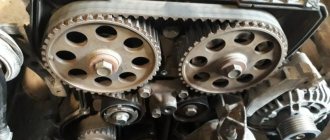Contitech and Gates are official suppliers of timing belts to the AvtoVAZ conveyor belt. Their products are installed on Lada Vesta and X-Ray cars. From the factory, 1.8-liter engines are equipped with a timing belt from Contitech, and 1.6-liter engines are equipped with Gates. At the same time, when servicing a car, you can replace one set with another.
In terms of quality, Contitech and Gates are on the same level. Their prices are also approximately the same, so it is impossible to single out just one manufacturer. You need to choose based on personal preferences and which spare part is easier to find in stores.
How to understand that it’s time to replace the timing belt on Vesta
Saving on this part is as foolish as saving on oil. If there is uneven operation of the engine, if the engine starts poorly, smokes, makes extraneous noise, or does not gain power, the timing drive is always suspect.
Before setting up the fuel equipment or adjusting the ignition timing, the mechanic must check the serviceability of this unit.
An inspection may reveal the following:
- The belt is oily.
- Coolant gets onto the belt.
- Cracks, tears, disrepair.
- Teeth partially cut off.
- One of the rollers of the mechanism has stopped, and the belt is rubbing against it with the smooth side. At the same time, it experiences increased mechanical and thermal stress.
In all these cases, the part must be changed:
- The installation marks are incorrect, but the valve is still not bent. Perhaps they were just set with an error, and the condition of the belt has not changed, then you can simply correct the mistake. But if the reason is wear and tear, then replacement is necessary.
- The belt has expired, but looks good - replace it.
- If you don’t know how long it has passed, change it, regardless of the condition.
When carrying out some work related to disassembling the drive unit, it is advisable to replace the belt early.
Reasons for wear include:
- Low quality product.
- Unsatisfactory condition of other components of the mechanism.
- Incorrect adjustment.
- The belt is overtightened, overstressed, and may even be humming.
- A loose belt tends to jump over a tooth and does not engage correctly.
Replacement algorithm and necessary tools
Replacing the timing belt of a Lada Vesta is a rather painstaking task and will take a lot of time from a person who is not a master auto mechanic. Many may even have a question: chain or belt? We do not rule out that a more durable device that does not tend to bend will soon replace the constantly breaking part of the Lada Vesta.
Lada Vesta is a compact small class sedan, located on the border of B and C classes, which began its history in 2015.
The following features of the car can be noted:
- Engine 87–114 horsepower (depending on configuration).
- Cars are equipped with both engines with a timing belt and a chain.
One of the main machine maintenance procedures is replacing the timing belt, which is a consumable item that gradually wears out. If you do not replace it on time, the belt may break sooner or later, which leads to bending of the valves. In this case, you will have to carry out large-scale repairs - install new valves, their guides and pistons. This long and costly process can be avoided if you check the timing mechanism in time and replace it as necessary.
How to choose a belt and components for Lada Vesta
VAZ installs timing drive components from Gates and Contitech on Lada Vesta engines. These are trusted manufacturers of spare parts whose product quality you can trust, but as they say: “beware of fakes.”
By the way, Gates has an original code on the packaging, which can be used to determine the authenticity of the spare part. However, it is not necessary to use only original spare parts. There are other manufacturers whose reputation is undoubted. Why not use Bosch components if it is convenient to buy them, but you have to wait for the original.
This part is not the most expensive in the car, but it is extremely important.
What to choose - a factory part or an analogue version
From the factory, Lada Vesta cars are equipped with a belt drive manufactured by Gates. For replacement, a set of parts is available with catalog number K015631XS.
Some owners prefer products
- Contitech (CT 1179)
- Bosch (1987949686).
All parts are produced by large enterprises and meet the requirements for timing drives. The car owner chooses the manufacturer at his own discretion.
It should be taken into account that parts from 16-valve engines of previous generations of VAZ are not suitable for Lada Vesta.
What is the service life of factory timing components?
The components of the timing belt set for twin-shaft Lada Vesta engines are considered to be idler and tension rollers. They are replaced at the same time as the belt at 180 thousand, but many experts recommend cutting this period in half.
However, the belt also passes through the pump gear. Its durability is considered the same as that of other components of the unit.
TZA produces pumps in two versions: Standard and PowerFull LUX. The first goes to the assembly line, but there are cases of failures at 30-50 thousand mileage. The second is improved in quality and performance. Has a larger bearing.
Preparation for replacing the timing belt on the Lada Vesta
The essence of replacing the timing belt is the same for all engines. It is necessary to install the timing shafts and the crankshaft (CV) in certain positions relative to each other and rigidly connect them with a toothed belt - to synchronize the operation of the two main engine mechanisms.
It is possible to do this work yourself, but it is advisable to contact a car service. The guiding document is the manufacturer's repair instructions.
At the preparatory stage, we will collect everything you need:
- Internal hex head 17 mm.
- 5 mm hexagonal socket wrench.
- Set of heads.
- Open-end wrenches.
- Set of Torx keys.
- Slotted screwdrivers.
- Crossbar or suitable jack.
- Torque wrench.
- Special wrench or circlip remover.
- Device for fixing camshafts 67.7811-9516 or 67.7811-9704.
- A device for fixing camshafts is needed to perform work on the 1.8 VAZ-21179 engine using factory technology. When working with simplified schemes, it will not be needed.
Engine options for Vesta
Vesta is available in variations with four different engines, which differ in volume and power:
- VAZ-11189 volume 1.6 l torque 140 N. m and power 64 kW/87 l. With.
- VAZ-21129 volume 1.6 l torque 148 N. m and power 78 kW/106 l. With.
- VAZ-21179 volume 1.8 l torque 170 N. m and power 90 kW/122 l. With.
- HR16DE volume 1.6 l torque 153 N. m and power 114 l. With.
Three variations were created and produced by AvtoVAZ itself, and the fourth model is a product of cooperation between Renault and Nissan, which differs from others in the presence of a mechanical chain instead of a timing belt.
Belt motors
Let's look at three versions of the Lada Vesta engine, equipped with a standard timing belt.
This model is the weakest of all available in the West and is a classic eight-valve. One of the features of the engine is its simplicity. Power is 64 kW/87 hp. pp., which is 27 less than the maximum version. And when it breaks, the valves bend.
Self-replacement on a 1.8 VAZ-21179 engine
The 1.8 VAZ-21179 engine does not have marks on the timing gears. This is due to the presence of a valve timing regulator. The sprockets are keyless on the shafts. This means that the gear is mounted on the shaft in any position.
With such a fit, technological marks on the gears are not only impractical, but can also lead to a fatal error. To fix the camshafts in the correct position, use the device 67.7811-9704. It is installed on the rear side of the cylinder head.
To do this, you need to remove the valve cover, and before that the receiver, the air conditioning pump, remove the generator, bracket, coils, throttle, camshaft position sensor, remove the sensor from the intake camshaft.
The amount of work is really large, and special devices, judging by publications on the Internet, will not be cheap. It is not economically feasible to carry out such repairs yourself.
To replace the timing belt on a 1.8 VAZ-21179 engine without the use of expensive devices, without laborious disassembly, you should turn to popular experience.
You can use alternative methods if you have the necessary experience in repairs and knowledge of the structure of internal combustion engines.
Belt removal
In accordance with the repair manual, disassemble the front part of the engine to gain access to all timing drive components. The technology is similar to that described for the 1.6 VAZ-21129 engine.
Apply installation marks. For this:
- Find the top dead center of cylinders 1 and 4 by removing the spark plug and using a long rod for this operation. By rotating the crankshaft you need to “catch” the highest position of the piston. In this case, the 20th tooth of the crankshaft pulley should be opposite the CV position sensor.
- On the rear plane of the cylinder head (cylinder head) there are two plugs opposite the ends of the camshafts. By removing one of them you can see whether the shaft is installed correctly. However, the second plug will not open the desired view. The correct installation of the intake shaft is judged by the position of the cam of the fourth cylinder. It will be visible through the open oil filler neck. You can check its correct position on a known-good machine, or ask experienced craftsmen.
- Fix the position of the timing gears. You can make this device yourself from a pin and two textolite plates placed on it. Each plate is secured with nuts at the top and bottom. The device locks the gears together.
- Carefully and clearly mark the installation marks with a marker. They will help in the future. But you must remember that they will be valid until you remove the gear from the shaft.
- Loosen the tensioner and remove the old belt.
Timing belt installation
1st method:
- Install a new belt, starting with the timing gears, then put it on the rollers, pump, and crankshaft gear.
- Use the adjusting roller to tighten the strap until it rests firmly on the gear teeth. Remove the device.
- Turn the HF until the three movable and fixed marks coincide.
- Make sure that the marks are correctly positioned, the exhaust shaft slots relative to the rear end of the cylinder head, and the position of the intake shaft cam.
- If everything is fine, finally adjust the belt tension and reassemble the machine in the reverse order.
The CV must be rotated an even number of times, since the gas distribution shafts rotate twice as slowly as the crankshaft. Their marks return to their place after one time.
2nd method:
Craftsmen suggest cutting the old belt lengthwise without removing it from the gears, removing the outer half, and putting on a new belt in its place, also half the thickness.
After this, remove the second half of the old belt and finally push the new part on. Then you can proceed to adjustment.
The method assumes, of course, that the old belt was installed correctly. No gear locking device is required. Rotate the HF, check the location of the shafts.
Belt adjustment
Make sure that the marks are correctly positioned, the exhaust shaft slots relative to the rear end of the cylinder head, and the position of the intake shaft cam.
If everything is fine, finally adjust the belt tension according to the instructions and reassemble the machine in the reverse order.
Which belt to buy
One of the important points when replacing a timing belt is choosing a new one.
On the VAZ-11189 engine, the standard part is numbered 21080100604082, with a standard price of about 300 rubles. It is produced in Poland (Gates company). The most popular analogue would be part VT25009 from China (VKT company), whose price varies around 250–300 rubles.
On the VAZ-21179 and 21129 models, the factory standard will be part number 8201069699, with Renault symbols. Country of manufacture – Poland (Gates), the price is in the range of 1100–1300 rubles. Three options will be proven analogues on vesta without negative reviews:
CONTITECH CT 1179 is a German-made part, the quality is not inferior to the original, and the price is 2.5 times cheaper (760 rubles). Is more often used than the original. Gates 5671 XS – Polish part, price around 1250 rubles. Problems in operation or quality are rare, the parameters are completely similar to the original part. Bosch 1987949686 - version from Germany, price about 800–1000 rubles, a well-known world brand. Mainly used in Renault cars. Belt replacement interval
According to the manufacturer's recommendations, replacement must be done after 180 thousand km. But, in practice, it is better to check and, if necessary, replace the part every 70–100 thousand kilometers.
The sad consequences of untimely replacement of the timing belt on Vesta
The timing belt behaves insidiously, striking without warning. If it jumped one tooth and the motor just started running unevenly, then it was a big luck. There is a chance to get away with a simple replacement. But where there is one tooth, there is a second, and the matter often ends in breakage.
But usually it works fine until the last moment and breaks off.
They often write on the Internet that this can lead to a major overhaul of the engine. Of course not. A complete overhaul is something completely different. And even a complete engine overhaul is not necessarily a major overhaul.
The consequences of a timing belt failure are the removal of the cylinder head, its defectiveness and subsequent repairs. As practice shows, prints remain on the piston heads. The valve pierces the piston if it breaks, and a piece of debris falls into the cylinder. But this is not the case.
The parts of the two mechanisms (valves and pistons) work in such a way that they are never at the same point. When the valve extends into the space above the piston, the latter inevitably moves down.
At top dead center, the exhaust valve is already rising during the closing process, and the intake valve is just beginning to open. It will move further into the space above the piston, but the piston will have time to go down. Coordinated work is disrupted when the connecting element breaks. The piston hits the valve and the latter fails.











